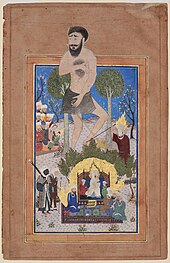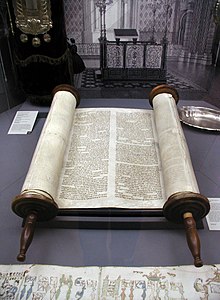Moses in Islam
In his childhood, he is put in a basket which flows towards the Nile, and is eventually discovered by Pharaoh's (Fir'awn) wife (not named in the Quran but called Asiya in Hadith), who takes Moses as her adopted son.Moses is reported to have met Muhammad in the seven heavens following his ascension from Jerusalem during the Night Journey (’Isrā’ Miʿrāj).[1] Islamic literature also describes a parallel relation between their people and the incidents that occurred in their lifetimes; the exodus of the Israelites from ancient Egypt is considered to be similar in nature to the migration of Muhammad and his followers from Mecca to Medina as both events unfolded in the face of persecution—of the Israelites by the ancient Egyptians, and of the early Muslims by the Meccans, respectively.[7] His revelations, such as the Ten Commandments, form part of the contents of the Torah and are central to the Abrahamic religions of Judaism and Christianity.[8][9] Consequently, Jews and Christians are designated as "People of the Book" for Muslims and are to be recognized with this special status wherever Islamic law is applied.Moses is further revered in Islamic literature, which expands upon the incidents of his life and the miracles attributed to him in the Quran and hadith, such as his direct conversations with God.Islamic literature states that around the time of Moses's birth, the Pharaoh had a dream in which he saw fire coming from the city of Jerusalem, which burned everything in his kingdom except in the land of the Israelites.[17] Experts of economics in Pharaoh's court advise him that killing the male infants of the Israelites would result in loss of manpower.Upon hearing their answers and about the old age of their father, although his identity is contested, generally accepted to be Prophet Shuaib, Moses waters their flocks for them.[citation needed] The Quran then narrates Moses being ordered to insert his hand into his clothes and when he revealed it, it shines a bright light.He warns them that if they insist in believing in Moses, he would cut their hands and feet on opposite sides, and crucify them on the trunks of palm trees for their betrayal of the Pharaoh.These punishments come in the form of floods that demolish their dwellings, swarms of locust that destroy the crops,[44] pestilence of lice that makes their life miserable,[45] toads that croak and spring everywhere, and the turning of all drinking water into blood.[49] One authentic hadith mentions that Angel Gabriel shoved sand into Pharaoh's mouth to stop him from saying anything more, fearing God would forgive him despite his insincerity.[52] When they stop in their travel to the Promised Land due to lack of water, Moses is commanded by God to strike a stone, and upon its impact twelve springs came forth, each for a specific tribe of the Israelites.Moses, having thus received the scriptures for his people, is informed by God that the Israelites has been tested in his absence, and they have gone astray by worshiping the Golden Calf.In the accounts of Moses’s death, al-Tabari reports, “[W]hile Musa was walking with his servant Joshua, a black wind suddenly approached.This act of witnessing is given to those who are “given the opportunity to give evidence of the depth of their faith by sacrificing their worldly lives, and will testify with the prophets on the Day of Judgment”.[93] He is regarded by Muslims as one of the five most prominent prophets in Islam, along with Jesus (Isa), Abraham (Ibrahim), Noah (Nuh) and Muhammad.The Quran describes the Torah as “guidance and a light" for the Israelites and that it contains teachings about the Oneness of God (Tawhid), prophethood and the Day of Judgment.Among the books of the complete Hebrew Bible (Genesis, Deuteronomy, Numbers, Leviticus and Exodus), only the Torah is considered to be divinely revealed instead of the whole Tanakh or the Old Testament.Modern Muslim scholars such as Mark N. Swanson and David Richard Thomas cite Deuteronomy 18:15–18 as foretelling the arrival of Muhammad.The authors Norman Solomon and Timothy Winter regard the story to be "intended as criticism of and warning to those who in order to avoid anthropomorphism, negate the Divine attributes".[27] Rumi mainly mentions the life of Moses by his encounter with the burning tree, his white hand, his struggle with the Pharaoh and his conversation with God on Mount Sinai.[117] The Shi'a Quranic exegesis scholar and thinker Muhammad Husayn Tabatabaei, in his commentary Balance of Judgment on the Exegesis of the Qur'an attempted to show the infallibility of Moses in regard to his request for a vision of God and his breaking of his promise to Al-Khidr as a part of the Shi'a doctorine of prophetic infallibility (Ismah).[118] Ibn Arabi considered the ark to be the personification of his humanity while the water of the river Nile to signifiy his imagination, rational thought and sense perception.[119] During the 20th century the story of Moses's confrontation with Pharaoh has been invoked by Islamists to justify their opposition to “disbelieving” secular regimes and tyrannical rulers.During the Iranian revolution of 1978–79, government troops were cautioned not to "Kill Moses [members of the Islamic opposition] for the sake of Pharaoh [the Shah’s regime]."[120] According to Ibn Abbas, Muhammad reported, "On the night of my Ascent to Heaven, I saw Moses, who was a tall, brown man..." [Al-Bukhari and Muslim].[121] While all hadiths discussing Moses's appearance agree that he was brown-skinned and extremely tall, there are differing depictions on the texture of his hair.7 portrays him having curly hair:[123] "The Prophet [...] said [...] he [Musa] is a brown curly-haired man riding a camel reigned with a strong jute rope.











ProphetRed SeaShu'aybṢaffūrahYūkābidArabicprophet and messengerIsraeliteFir'awnHadithMidianMuhammadJerusalemNight Journeyfive obligatory prayersexodus of the Israelites from ancient Egyptof the Israelites by the ancient Egyptiansof the early Muslims by the MeccansTen CommandmentsAbrahamic religionsJudaismChristianityChristiansPeople of the BookIslamic lawlegendaryTawratṢuḥuf MūsāShuaibAshuraJabal MusaUlu'l azm prophetsIsraelitesHebrew BibleeconomicsmanpowerJami' al-tawarikhJochebedIslamic prophetsProphets in the QuranʾĀdamʾIdrīsNūḥṢāliḥʾIbrāhīmAbrahamLūṭʾIsmāʿīlIshmaelʾIsḥāqYaʿqūbYūsufJosephShuʿaybJethroHārūnDhu al-KiflEzekielDāūdSulaymānSolomonYūnusʾIlyāsElijahAlyasaʿElishaZakarīyaZechariahYaḥyāʿĪsāMuḥammadMain eventsStories of the ProphetsThe Three MessengersAbrahamic prophetsIsra'iliyat hadithrubiesGabrielMidian MountainsGulf of AqabaArabian PeninsulaAsh-ShaamSinai PeninsulaSamaritanmanslaughterProphet ShuaibBiblical Mount SinaiAt-TurValley of TuwaAl-Buq‘ah Al-Mubārakahancient EgyptSurah MaryamSurah An-Nisahis staffsorceryPharaohcrucifypunishmentslocustRamesses IIMount SinaiSamiriscripturesGolden Calfthe Promised LandexegesisGod's carelumberjackAl-KhidrAlawiteShrine of KhidrSamandağTurkeyMusa va 'Ujhayaa'scrotal herniaAzraelNabi MusatwilightMaqam El-Nabi MusaJerichoJudeanFatimidTaiyabiDawoodi Bohramosque

